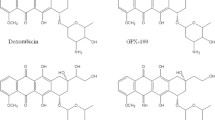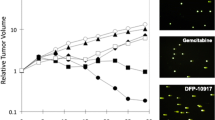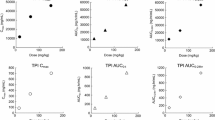Abstract
Purpose
This study was designed to test the short-term toxicity of DHA-dFdC in a mouse model and its efficacy in a mouse model of leukemia at or below its repeat-dose maximum tolerated dose (RD-MTD).
Method
A repeat-dose dose-ranging toxicity study was designed to determine the tolerability of DHA-dFdC when administered to DBA/2 mice by intravenous (i.v.) injection on a repeat-dose schedule (i.e. injections on days 0, 3, 7, 10, and 13). In order to determine the effect of a lethal dose of DHA-dFdC, mice were injected i.v. with three doses of DHA-dFdC at 100 mg/kg on days 0, 3, and 5 (i.e. a lethal-RD). The body weight of mice was recorded two or three times a week. At the end of the study, major organs (i.e. heart, liver, spleen, kidneys, lung, and pancreas) of mice that received the lethal-RD or RD-MTD were weighed, and blood samples were collected for analyses. Finally, DHA-dFdC was i.v. injected into DBA/2 mice with syngeneic L1210 mouse leukemia cells to evaluate its efficacy at or below RD-MTD.
Results
The RD-MTD of DHA-dFdC is 50 mg/kg. At 100 mg/kg, a lethal-RD, DHA-dFdC decreases the weights of mouse spleen and liver and significantly affected certain blood parameters (i.e. white blood cells, lymphocytes, eosinophils, and neutrophil segmented). At or below its RD-MTD, DHA-dFdC significantly prolonged the survival of L1210 leukemia-bearing mice.
Conclusion
DHA-dFdC has dose-dependent toxicity, affecting mainly spleen at a lethal-RD. At or below its RD-MTD, DHA-dFdC is effective against leukemia in a mouse model.





Similar content being viewed by others
Abbreviations
- ALP:
-
Alkaline phosphatase
- ALT:
-
Alanine transaminase
- AST:
-
Aspartate transaminase
- BUN:
-
Blood urea nitrogen
- CPK:
-
Creatine phosphokinase
- dFdC:
-
2`, 2`-difluorodeoxycytidine HCl
- DHA:
-
Docosahexaenoic acid
- DHA-dFdC:
-
4-(N)-docosahexaenoyl 2´, 2´-difluorodeoxycytidine
- HCT:
-
Hematocrit value
- HGB:
-
Hemoglobin level
- i.p.:
-
Intraperitoneally
- i.v.:
-
Intravenous
- ILS:
-
Increase in life span
- Lethal-RD:
-
Lethal-repeat dose
- PSCs:
-
Pancreatic stellate cells
- PUFA:
-
Polyunsaturated fatty acid
- RBC:
-
Red blood cell count
- RD-MTD:
-
Repeat-dose maximum tolerated dose
- T/U:
-
The ratio of the mean survival time of treated group to the median survival time of the untreated group
- WBC:
-
White blood cells
References
Carmichael J, Fink U, Russell RC, Spittle MF, Harris AL, Spiessi G, Blatter J. Phase II study of gemcitabine in patients with advanced pancreatic cancer. Br J Cancer. 1996;73(1):101–5.
Burris 3rd HA, Moore MJ, Andersen J, Green MR, Rothenberg ML, Modiano MR, Cripps MC, Portenoy RK, Storniolo AM, Tarassoff P, Nelson R, Dorr FA, Stephens CD, Von Hoff DD. Improvements in survival and clinical benefit with gemcitabine as first-line therapy for patients with advanced pancreas cancer: a randomized trial. J Clin Oncol. 1997;15(6):2403–13.
Hoang T, Kim K, Jaslowski A, Koch P, Beatty P, McGovern J, Quisumbing M, Shapiro G, Witte R, Schiller JH. Phase II study of second-line gemcitabine in sensitive or refractory small cell lung cancer. Lung Cancer. 2003;42(1):97–102.
Pfisterer J, Plante M, Vergote I, du Bois A, Hirte H, Lacave AJ, Wagner U, Stahle A, Stuart G, Kimmig R, Olbricht S, Le T, Emerich J, Kuhn W, Bentley J, Jackisch C, Luck HJ, Rochon J, Zimmermann AH, Eisenhauer E. Gemcitabine plus carboplatin compared with carboplatin in patients with platinum-sensitive recurrent ovarian cancer: an intergroup trial of the AGO-OVAR, the NCIC CTG, and the EORTC GCG. J Clin Oncol. 2006;24(29):4699–707.
Yardley DA. Gemcitabine plus paclitaxel in breast cancer. Semin Oncol. 2005;32(4 Suppl 6):S14–21.
Wong A, Soo RA, Yong WP, Innocenti F. Clinical pharmacology and pharmacogenetics of gemcitabine. Drug Metab Rev. 2009;41(2):77–88.
de Sousa CL, Monteiro G. Gemcitabine: metabolism and molecular mechanisms of action, sensitivity and chemoresistance in pancreatic cancer. Eur J Pharmacol. 2014;741:8–16.
Casper ES, Green MR, Kelsen DP, Heelan RT, Brown TD, Flombaum CD, Trochanowski B, Tarassoff PG. Phase II trial of gemcitabine (2,2'-difluorodeoxycytidine) in patients with adenocarcinoma of the pancreas. Investig New Drugs. 1994;12(1):29–34.
Storniolo AM, Allerheiligen SR, Pearce HL. Preclinical, pharmacologic, and phase I studies of gemcitabine. Semin Oncol. 1997;24(2 Suppl 7):S7-2–7.
Merendino N, Costantini L, Manzi L, Molinari R, D'Eliseo D, Velotti F. Dietary omega −3 polyunsaturated fatty acid DHA: a potential adjuvant in the treatment of cancer. Biomed Res Int. 2013;2013:310186.
Chamras H, Ardashian A, Heber D, Glaspy JA. Fatty acid modulation of MCF-7 human breast cancer cell proliferation, apoptosis and differentiation. J Nutr Biochem. 2002;13(12):711–6.
Serini S, Piccioni E, Merendino N, Calviello G. Dietary polyunsaturated fatty acids as inducers of apoptosis: implications for cancer. Apoptosis. 2009;14(2):135–52.
Spencer L, Mann C, Metcalfe M, Webb M, Pollard C, Spencer D, Berry D, Steward W, Dennison A. The effect of omega-3 FAs on tumour angiogenesis and their therapeutic potential. Eur J Cancer. 2009;45(12):2077–86.
Horia E, Watkins BA. Complementary actions of docosahexaenoic acid and genistein on COX-2, PGE2 and invasiveness in MDA-MB-231 breast cancer cells. Carcinogenesis. 2007;28(4):809–15.
D'Eliseo D, Manzi L, Merendino N, Velotti F. Docosahexaenoic acid inhibits invasion of human RT112 urinary bladder and PT45 pancreatic carcinoma cells via down-modulation of granzyme B expression. J Nutr Biochem. 2012;23(5):452–7.
Li S, Qin J, Tian C, Cao J, Fida G, Wang Z, Chen H, Qian Z, Chen WR, Gu Y. The targeting mechanism of DHA ligand and its conjugate with gemcitabine for the enhanced tumor therapy. Oncotarget. 2014;5(11):3622–35.
Arterburn LM, Boswell KD, Koskelo E, Kassner SL, Kelly C, Kyle DJ (2000) A combined subchronic (90-day) toxicity and neurotoxicity study of a single-cell source of docosahexaenoic acid triglyceride (DHASCO oil). Food Chem Toxicol. 38:35–49.
Nelson GJ, Schmidt PC, Bartolini GL, Kelley DS, Kyle D. The effect of dietary docosahexaenoic acid on plasma lipoproteins and tissue fatty acid composition in humans. Lipids. 1997;32(11):1137–46.
Ryan AS, Keske MA, Hoffman JP, Nelson EB. Clinical overview of algal-docosahexaenoic acid: effects on triglyceride levels and other cardiovascular risk factors. Am J Ther. 2009;16(2):183–92.
Nelson GJ, Schmidt PS, Bartolini GL, Kelley DS, Kyle D. The effect of dietary docosahexaenoic acid on platelet function, platelet fatty acid composition, and blood coagulation in humans. Lipids. 1997;32(11):1129–36.
Park Y, Harris W. EPA, but not DHA, decreases mean platelet volume in normal subjects. Lipids. 2002;37(10):941–6.
Kelley DS, Taylor PC, Nelson GJ, Mackey BE. Dietary docosahexaenoic acid and immunocompetence in young healthy men. Lipids. 1998;33(6):559–66.
Thies F, Nebe-von-Caron G, Powell JR, Yaqoob P, Newsholme EA, Calder PC. Dietary supplementation with gamma-linolenic acid or fish oil decreases T lymphocyte proliferation in healthy older humans. J Nutr. 2001;131(7):1918–27.
He K, Xun P, Brasky TM, Gammon MD, Stevens J, White E. Types of fish consumed and fish preparation methods in relation to pancreatic cancer incidence: the VITAL cohort study. Am J Epidemiol. 2013;177(2):152–60.
Zheng JS, Hu XJ, Zhao YM, Yang J, Li D. Intake of fish and marine n-3 polyunsaturated fatty acids and risk of breast cancer: meta-analysis of data from 21 independent prospective cohort studies. BMJ. 2013;346:f3706.
Arshad A, Chung WY, Steward W, Metcalfe MS, Dennison AR. Reduction in circulating pro-angiogenic and pro-inflammatory factors is related to improved outcomes in patients with advanced pancreatic cancer treated with gemcitabine and intravenous omega-3 fish oil. HPB: Off J Int Hepato Pancreato Biliary Assoc. 2013;15(6):428–32.
Arshad A, Isherwood J, Mann C, Cooke J, Pollard C, Runau F, Morgan B, Steward W, Metcalfe M, Dennison A. Intravenous omega-3 fatty acids plus gemcitabine: potential to improve response and quality of life in advanced pancreatic cancer. JPEN J Parenteral Enter Nutr 2015.
Camargo Cde Q, Mocellin MC, Pastore Silva Jde A, Fabre ME, Nunes EA. Trindade EB. Fish oil supplementation during chemotherapy increases posterior time to tumor progression in colorectal cancer. Nutr Cancer. 2016;68(1):70–6.
Murphy RA, Mourtzakis M, Chu QS, Baracos VE, Reiman T, Mazurak VC. Supplementation with fish oil increases first-line chemotherapy efficacy in patients with advanced nonsmall cell lung cancer. Cancer. 2011;117(16):3774–80.
Colomer R, Moreno-Nogueira JM, Garcia-Luna PP, Garcia-Peris P, Garcia-de-Lorenzo A, Zarazaga A, Quecedo L, del Llano J, Usan L, Casimiro C. N-3 fatty acids, cancer and cachexia: a systematic review of the literature. Br J Nutr. 2007;97(5):823–31.
Heller AR, Rossel T, Gottschlich B, Tiebel O, Menschikowski M, Litz RJ, Zimmermann T, Koch T. Omega-3 fatty acids improve liver and pancreas function in postoperative cancer patients. Int J Cancer. 2004;111(4):611–6.
Naguib YW, Lansakara PD, Lashinger LM, Rodriguez BL, Valdes S, Niu M, Aldayel AM, Peng L, Hursting SD, Cui Z. Synthesis, characterization, and in vitro and in vivo evaluations of 4-(N)-docosahexaenoyl 2', 2'-difluorodeoxycytidine with potent and broad-Spectrum antitumor activity. Neoplasia. 2016;18(1):33–48.
Montgomery CA. Oncological and toxicological research: alleviation and control of pain and distress in laboratory animals. Cancer Bull. 1990;42:230–7.
NRC. The Guide for the Care and Use of Laboratory Animals. Washington, D.C: National Academies Press; 2011.
Gianasi E, Wasil M, Evagorou EG, Keddle A, Wilson G, Duncan R. HPMA copolymer platinates as novel antitumour agents: in vitro properties, pharmacokinetics and antitumour activity in vivo. Eur J Cancer. 1999;35(6):994–1002.
Andersson L, Davies J, Duncan R, Ferruti P, Ford J, Kneller S, Mendichi R, Pasut G, Schiavon O, Summerford C, Tirk A, Veronese FM, Vincenzi V, Wu G. Poly(ethylene glycol)-poly(ester-carbonate) block copolymers carrying PEG-peptidyl-doxorubicin pendant side chains: synthesis and evaluation as anticancer conjugates. Biomacromolecules. 2005;6(2):914–26.
Reddy LH, Marque PE, Dubernet C, Mouelhi SL, Desmaele D, Couvreur P. Preclinical toxicology (subacute and acute) and efficacy of a new squalenoyl gemcitabine anticancer nanomedicine. J Pharmacol Exp Ther. 2008;325(2):484–90.
Raabe BM, Artwohl JE, Purcell JE, Lovaglio J, Fortman JD. Effects of weekly blood collection in C57BL/6 mice. J Am Assoc Lab Anim Sci. 2011;50(5):680–5.
Oliver SAG, Smith JE, Kaneko JJ. Erythrocyte Structure and Function. In: Douglas J, Weiss KJW, editor. Schalm's Veterinary Hematology. Ames: John Wiley & Sons; 2010. p. 123–130.
Hall R, Everds N. Principles of Clinical Pathology for Toxicology Studies. In. Principles and Methods of Toxicology, Fifth Edition: CRC Press, Boca Raton; 2007. p. 1317–1358.
MacNeill A. Clinical Biochemistry of Domestic Animals, 6th Edition by Editors: J. Jerry Kaneko, John W. Harvey, and Michael L. Bruss. Veterinary Clinical Pathology. 2009;38(4):545.
Department of Health and Human Services UFaDA. Substances affirmed as generally recognized as safe: menhaden oil. In. Washington: Food and Drug Administration, HHS. 1997. p. 30751–30757.
Klek S. Omega-3 Fatty Acids in Modern Parenteral Nutrition: A Review of the Current Evidence. J Clin Med. 2016;5(3).
Haqq J, Howells LM, Garcea G, Dennison AR. Targeting pancreatic cancer using a combination of gemcitabine with the omega-3 polyunsaturated fatty acid emulsion, Lipidem. Mol Nutr Food Res. 2016;60(6):1437–47.
Author information
Authors and Affiliations
Corresponding author
Rights and permissions
About this article
Cite this article
Valdes, S., Naguib, Y.W., Finch, R.A. et al. Preclinical Evaluation of the Short-Term Toxicity of 4-(N)-Docosahexaenoyl 2´, 2´- Difluorodeoxycytidine (DHA-dFdC). Pharm Res 34, 1224–1232 (2017). https://doi.org/10.1007/s11095-017-2139-x
Received:
Accepted:
Published:
Issue Date:
DOI: https://doi.org/10.1007/s11095-017-2139-x




